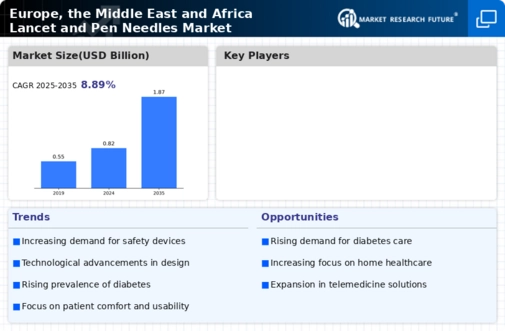Market Share
Europe Lancet Pen Needles Market Share Analysis
The Lancet and Pen Needles market cater to various end users, including hospitals, clinics, diagnostic centers and pathology laboratories, home diagnostics, and other healthcare facilities. In contemporary healthcare settings, hospitals are increasingly adopting lancing devices and lancets as preventive measures against needle stick injuries. Simultaneously, pathology and diagnostics labs are incorporating safety lancets due to a surge in blood sampling procedures prompted by the escalating prevalence of infectious diseases. The home diagnostics sector is witnessing a rising demand for monitoring devices, with the simplicity of use contributing to the widespread adoption of safety lancets in this segment. Furthermore, the growing demand for high-quality lancets and the implementation of safety regulations regarding blood sampling and transfusion procedures have been instrumental in propelling market growth. The Lancet and Pen Needles market are experiencing increased momentum driven by the global rise in diabetes prevalence and the ongoing improvements in healthcare regulations concerning medical devices. Among the diverse end-user categories, Hospitals and Clinics stand out as dominant forces in the global lancet and pen needles market, claiming a substantial share of 34%, surpassing other types. The Hospitals and Clinics market is anticipated to achieve a valuation of USD 3,458.25 million by the conclusion of 2027, exhibiting a noteworthy Compound Annual Growth Rate (CAGR) of 10.68% during the period from 2017 to 2027.
Safety lancets, characterized as single-use devices for blood sampling, are indispensable in mitigating the risk of sharp injuries during phlebotomy procedures in hospitals, outpatient facilities, and clinics. Healthcare providers and patients in these settings are susceptible to sharp injuries, highlighting the crucial role of safety devices in creating secure environments. The World Health Organization (WHO) asserts that safety devices have the potential to prevent nearly 55% of percutaneous injuries, underscoring their significance in bolstering safety standards across healthcare practices. As a result, safety lancets play a pivotal role in averting sharp object injuries, providing a secure environment for both healthcare professionals and patients.











Leave a Comment